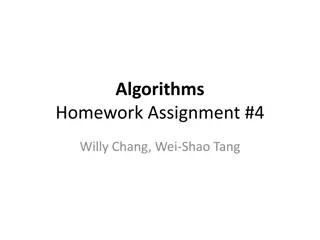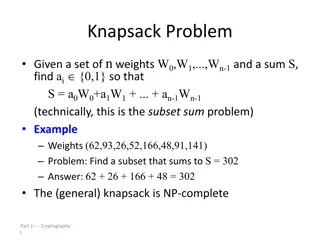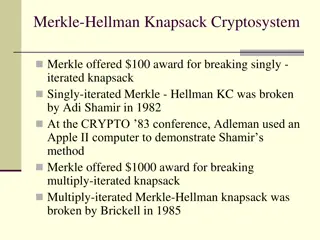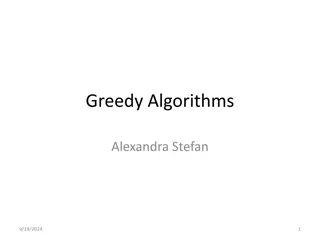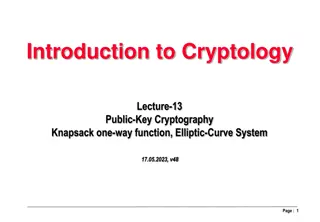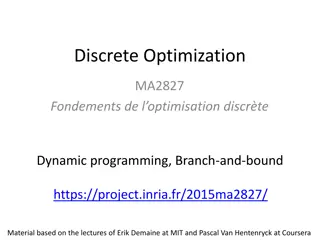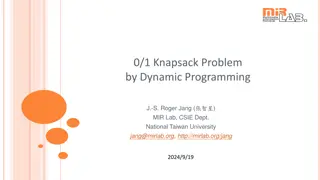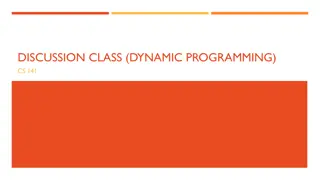Understanding the Knapsack Problem in Dynamic Programming
Explore the concept of the Knapsack Problem in dynamic programming, focusing on the 0/1 Knapsack Problem and the greedy approach. Understand the optimal substructure and greedy-choice properties, and learn how to determine the best items to maximize profit within a given weight constraint. Compare the solutions derived through dynamic programming and the greedy algorithm, highlighting the importance of selecting the most efficient approach based on the problem's characteristics.
Download Presentation

Please find below an Image/Link to download the presentation.
The content on the website is provided AS IS for your information and personal use only. It may not be sold, licensed, or shared on other websites without obtaining consent from the author. Download presentation by click this link. If you encounter any issues during the download, it is possible that the publisher has removed the file from their server.
E N D
Presentation Transcript
Dynamic Programming Knapsack Problem CS 3100 DSA2 Mark Floryan 1
Dynamic Programming and Greedy Approach TOPICS: 0/1 Knapsack 2
Reminder: Knapsack Problems Pages 425-427 in textbook Description: Thief robbing a store finds n items, each with a profit amount pi and a weight wi Wants to steal as valuable a load as possible But can only carry total weight C in their knapsack Which items should they take to maximize profit? Form of the solution: an xi value for each item, showing if (or how much) of that item is taken Inputs are: C, n, the pi and wi values 4
Two Types of Knapsack Problem 0/1 knapsack problem Each item is discrete: must choose all of it or none of it. So each xi is 0 or 1 Greedy approach does not produce optimal solutions But dynamic programming does Fractional knapsack problem (AKA continuous knapsack) Can pick up fractions of each item. So each xi is a value between 0 or 1 A greedy algorithm finds the optimal solution 5
A Bit More Terminology Problems solvable by both Dynamic Programming and the Greedy approach have the optimal substructure property: An optimal solution to a problem contains within it optimal solutions to subproblems This allows us to build a solution one step at a time, because we can solve increasingly smaller problems with confidence Dynamic Programming not a good solution for problems that have the greedy-choice property: We can assemble a globally-optimal solution for the current by making a locally-optimal choice, without considering results from subproblems 6
0/1 knapsack n = 3, C = 4 Let s try this same greedy solution with the 0/1 version New example inputs Item Value Weight Ratio 1 3 1 3 2 5 2 2.5 1. Item 1 first. So x1 is 1. Capacity used is 1 of 4. Profit so far is 3. Item 2 next. There s room for it! So x2 is 1. Capacity used is 3 of 4. Profit so far is 3 + 5 = 8. Item 3 would be next, but its weight is 3 and knapsack only has 1 unit left! So x3 is 0. Total profit is 8. xi = (1, 1, 0) 3 6 3 2 2. 3. But picking items 1 and 3 will fit in knapsack, with total value of 9 Thus, the greedy solution does not produce an optimal solution to the 0/1 knapsack algorithm Greedy choice left unused room, but we can t take a fraction of an item The 0/1 knapsack problem doesn t have the greedy choice property 7
Reminders about Dynamic Programming Requires Optimal Substructure Solution to larger problem contains the solutions to smaller ones Strategy: 1. Identify the recursive structure of the problem What is the last thing done? 2. Formulate a data structure (array, table) that can look-up solution to any sub-problem in constant time 3. Select a good order for solving subproblems Bottom Up : Iteratively solve smallest to largest Top Down : Solve each recursively. (We won t do this for 0/1 knapsack.) 8
Dynamic programming solution to 0/1 We need to: Identify a recursive definition of how a larger solution is built from optimal results for smaller sub-problems. For 0/1 knapsack, what a sub-problem solution look like? What can be smaller ? Smaller capacity for the knapsack Fewer items 9
Some assumptions and observations Given a set S of the objects and a capacity C We assume the optimal solution is O, a subset of S For example, the items in O could be the bolded ones: S = { s1, s2, s3, , sk-1, sk, , sn } Note that the last item sn may or may not be in the solution O Let s use subscripts on Ok and Skwhen we re talking about the first k items BTW, we ll assume C and all wi are integer values And, most books etc. use W for what we re calling C 10
Recursive Structure What s a recursive definition of how a solution of size n is built from optimal results for smaller sub-problems? S = { s1, s2, s3, , sn-1 , sn } Let s say sn On (last item is not in optimal solution for Sn): Last item didn t add anything to best solution for smaller subproblem We need optimal solution On-1 for the following smaller subproblem Sn-1: n-1 items using same knapsack capacity C Let s say sn O (last item is in optimal solution for Sn): Last item contributed wito total weight we re carrying We need optimal solution On-1 for the following smaller subproblem Sn-1 : n-1 items using reduced capacity C-wn (Note that getting smaller decreases number of items and also maybe capacity.) 11
First Step: Getting Things Started For sub-problems, what variables change in size? Maybe C (the capacity) and definitely k (number of items to steal) Define what we re calculating: call it Knap(k, w) Note: we ll use w for the changing capacity value in Knap(), but keep C as the overall total capacity for the entire problem. (Sorry if confusing!) Whether we do recursion of work bottom-up, we need to know the smallest cases Some small or boundary cases: No knapsack capacity (w=0), can t add an item, so Knap(k, 0) = 0 Nothing to steal (k=0), so Knap(0, w) = 0 12
Three cases to calculate Knap(k, w) Three cases for calculating Knap(k, w): 1. There is sufficient capacity to add item sk to the knapsack, and that creates an optimal solution for k items 2. There is sufficient capacity to add item sk to the knapsack, and that does NOT create an optimal solution for k items 3. There is insufficient capacity to add item sk to the knapsack Case 3 is easy to determine; we ll have to compute whether 1 or 2 is optimal How do we know which is optimal? Compute both, pick larger value! 13
Case 1: Sufficient capacity and Optimal There is sufficient capacity to add item sk to the knapsack, and that creates an optimal solution for k items Thus, our solution for the first k items is when we add item sk to the optimal solution for the first k-1 items But by adding item sk to the knapsack, we have reduced capacity In particular, we only have w-wk for to steal the first k-1 items So the value for Knap(k, w) = vk + Knap(k-1, w-wk) 14
Case 2: Sufficient Capacity but Non-optimal There is sufficient capacity to add item sk to the knapsack, and that does NOT create an optimal solution for k items Thus, our solution for the first k items is when we do NOT add item sk to the solution for the first k-1 items Since we are not adding item sk to the knapsack, the solution is the optimal solution to steal the first k-1 items with the same capacity So Knap(k, w) = Knap(k-1, w) 15
Case 3: Insufficient Capacity There is insufficient capacity to add item sk to the knapsack This is because w-wk < 0 (i.e. w < wk) Then Knap(k, w) = Knap(k-1, w) Since we can t add item sk to the knapsack, the solution is the same as the first k-1 items with the same capacity Note that this formula is the same as case 2 16
Putting It All Together Recursively define solutions to sub-problems Base Case Knap(k,0) = 0 Knap(0,w) = 0 Recursive Case Knap(k, w) = max( Knap(k-1, w), Knap(k-1, w-wk) + vk ) Subproblems are smaller! No room for sk or not part optimal solution sk is part of optimal solution 17
Reminders about Dynamic Programming Requires Optimal Substructure Solution to larger problem contains the solutions to smaller ones Strategy: 1. Identify the recursive structure of the problem What is the last thing done? 2. Formulate a data structure (array, table) that can look-up solution to any sub-problem in constant time 3. Select a good order for solving subproblems Bottom Up : Iteratively solve smallest to largest Top Down : Solve each recursively. (We won t do this for 0/1 knapsack.) 18
Lookup Table We want a data-structure that allows us to lookup a sub- problem value in O(1) time Knap(k, w) has two parameters, so two-dimensional array works great. Make an array called V[k, w] Store solution to Knap(k, w) at position V[k, w] 19
Determining the cases To determine between cases 1 and 2 Simply compute both values, and take the higher if (w-wk< 0) // not room for item k V[k, w] = V[k-1, w] // best result for k-1 items else { val_with_kth = vk + V[k-1, w-wk] // Case 1 above val_for_k-1 = V[k-1, w] // Case 2 above V[k, w] = max( val_with_kth, val_for_k-1 ) } 20
Put Values in Table Write a loop that fills in the table one cell at a time The table fills in one row at a time, moving rightwards and downwards V[k,w] w = 0 w = 1 w = 2 w = C k = 0 0 0 0 0 0 k = 1 0 k = 2 0 0 k = n 0 21
Pseudo-code Knapsack(v, w, C) { for (w = 0 to C) V[0, w] = 0 for (k = 0 to n) V[k, 0] = 0 for (k = 1 to n) { // loop over all rows for (w = 1 to C) { // loop over all columns if (w-wk < 0) // not room for item k V[k, w] = V[k-1, w] // best result for k-1 items else { val_with_kth = vk + V[k-1, w-wk] // Case 1 above val_for_k-1 = V[k-1, w] // Case 2 above V[k, w] = max( val_with_kth, val_for_k-1 ) } } } return V[n,C] } 22
But our solution is only the value! Value V[n, C] is the optimal value To find which items were chosen, we can trace backward through the table starting at V[n, C] If V[k, w] = V[k-1, w], then sk is not an item in the knapsack (this was from cases 2 and 3). Look at V[k-1, w] next. Otherwise, sk is an item in the knapsack, and we look at V[k-1, w-wk] next (this was from case 1) 23







